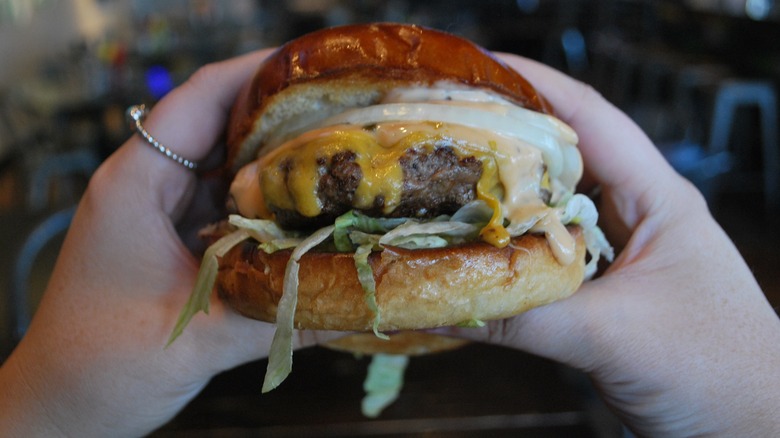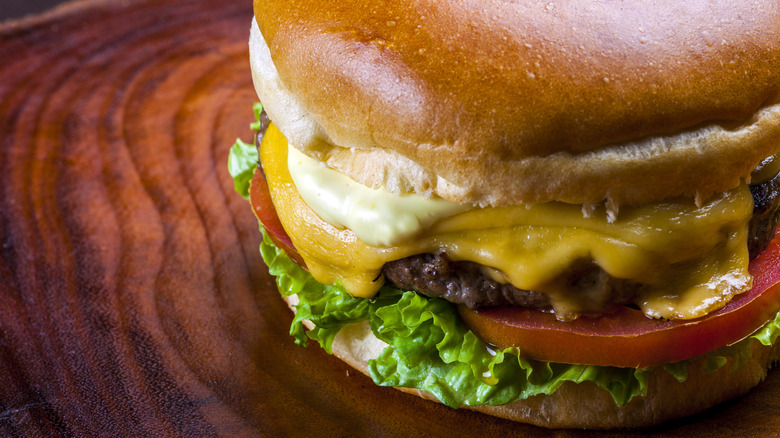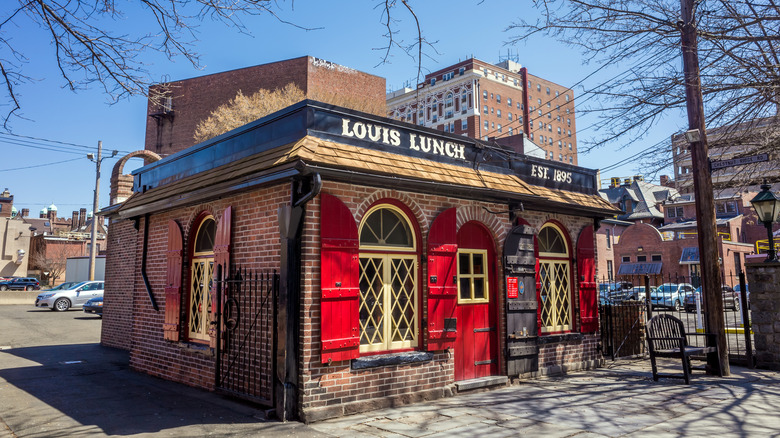How Connecticut Cheeseburgers Stand Out From The Crowd
No, we're not talking about "The Simpsons'" infamous "steamed hams" but rather steamed cheeseburgers, a real Connecticut tradition. Steaming may at first seem antithetical to the idea of a cheeseburger. Typical cheeseburgers are grilled to charred perfection and topped with a slice (or two) of cheese. (American cheese is a favorite of many chefs, including Bobby Flay, who can't stand fancy burger upgrades.) However, Connecticut likes to do things a little differently. Ted's, a Meriden, Connecticut, restaurant originated the regional favorite steamed cheeseburger in 1959.
Ted's burgers are prepared in a specialized steamer. Each 5 ½ ounce beef patty is nestled in a square metal container that's placed in an oven over a larger pan of water. Along with each beef patty, 2 ounces of cheddar are also added to the steaming oven. The beef is cooked all the way through, and the cheese is cooked until melted. Then, each patty is placed on a bun, and the melted cheese is poured over the patty. Steaming makes each burger extra juicy, and the cheese covers the burger like a blanket of gooey, melty goodness. This comes at the expense of the charred taste of a grilled burger, and no, Ted's will not cook your burger medium-rare. So if you want a true Connecticut cheeseburger, you'll have to get it well-done.
Steam power
The concept of a steamed cheeseburger may seem blasphemous to some. Those who critique the cooking method lament the fact that steaming causes a loss of fat within the patty — and lost fat often means lost flavor. While steamed burgers are extra moist, that moisture comes from the infusion of water rather than the retention of fat, which means that while the burger is "juicy," it might not be the most flavorful. However, the cheesy cover of steamed cheddar than enrobes the burger makes up for this. The cheese, not the patty, is the real star of the show.
While Ted's burgers are tasty, it isn't the only restaurant known for steamed burgers. The Kansas-based fast food icon White Castle, founded in 1921, also famously steams its burgers right alongside its buns (and onions, too). However, unlike White Castle, Ted's burgers aren't steamed on a pile of onions on the grill but in a pan of their own juices. Although the Connecticut restaurant didn't exactly invent steamed burgers, it did create a method of steaming that is now a unique trademark of the region.
A state of peculiar burgers
Connecticut's unique approach to burger-making doesn't end (or start) with Ted's steamed burgers. The little New England state has a big name in the world of hamburgers, and one Connecticut eatery, Louis Lunch in New Haven, claims to have invented the dish entirely. Established in 1895, Louis Lunch doesn't steam its burgers like Ted's. It cooks its signature burgers in broilers that date back to 1929.
After the burgers are cooked, they are placed on white toast (not buns) and topped with your choice of cheese, tomato, or onion. No ketchup is permitted in the restaurant. (Seriously, you will be asked to leave if you ask for ketchup.) It seems that ketchup is a culinary taboo that brings multiple regions together. Chicago basically bans the condiment on its famous hot dogs.
Both Ted's and Louis Lunch serve up burgers in a unique and totally non-traditional way, and each has become an icon in its own right. Any burger connoisseur worth their weight in beef will want to mark Connecticut as a must-visit state on their tour of unique American food.


